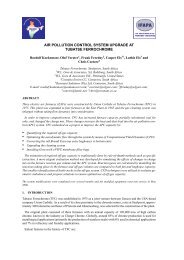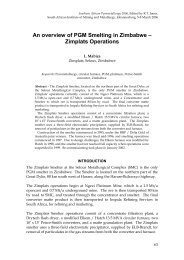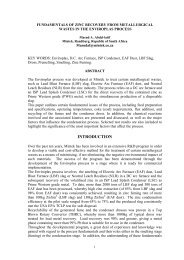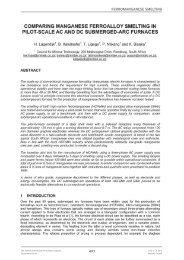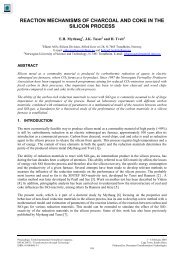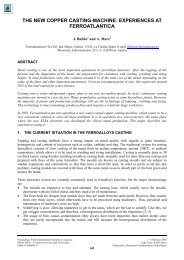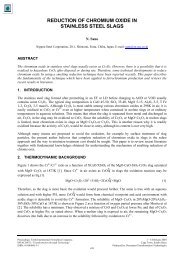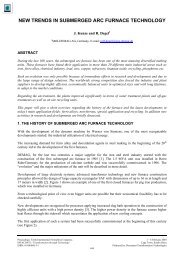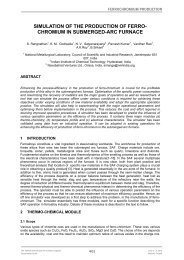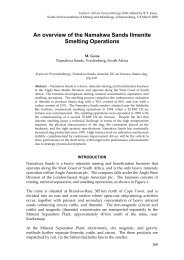ferro alloy design, ferro alloy selection and utilisation ... - Pyro.co.za
ferro alloy design, ferro alloy selection and utilisation ... - Pyro.co.za
ferro alloy design, ferro alloy selection and utilisation ... - Pyro.co.za
- No tags were found...
You also want an ePaper? Increase the reach of your titles
YUMPU automatically turns print PDFs into web optimized ePapers that Google loves.
Applications <strong>and</strong> Uses1.5 Value related to informationOne of the reasons why having raw materials with a st<strong>and</strong>ard specification was so important forsteelmakers was that this was a necessary to be able to calculate <strong>alloy</strong> needs.Today with the help of <strong>co</strong>mputerized <strong>alloy</strong> optimi<strong>za</strong>tion it is in fact as easy to h<strong>and</strong>le unique batchinformation as st<strong>and</strong>ard information. In fact most special steel makers have an organi<strong>za</strong>tional mindsetfor batch operations when it <strong>co</strong>mes to <strong>alloy</strong>ing, this means that for them, the final chemistry mustbe<strong>co</strong>me exactly right on each particular tap rather than be<strong>co</strong>ming very good in average.For a particular batch of material, it would mean that it is evaluated on its own merits rather than onthe worst part of the production.For practical reasons steelmakers want narrow elemental ranges in their purchased <strong>alloy</strong>s but this ismore caused by stock-keeping <strong>and</strong> logistics rather than for any metallurgical reason.1.6 What about inclusions?Inclusions that are of importance for stainless steel manufacturers are generally formed late in theprocess. The inclusions may be oxides, nitrides or carbides alone or in <strong>co</strong>mplexes. The effect of theinclusions in the steel is surface errors, <strong>co</strong>rrosion initiation <strong>and</strong> mechanical insufficiencies.Some of the inclusions are formed as a <strong>co</strong>nsequence of late scrap <strong>and</strong> <strong>alloy</strong> additions, see figure 3.What happens in such situations is that an <strong>alloy</strong> lump with a high melting point <strong>co</strong>mpared to the steelbe<strong>co</strong>mes a suitable surface for inclusion formation <strong>and</strong> growth. Inclusion initiation, growth or removalis seldom or never neither a problem nor a possibility in the <strong>co</strong>nverter. The turbulence in the <strong>co</strong>nverteris simply too great to allow a structured inclusion engineering. This has to be done downstream in acalmer ladle.Only a very small amount of the <strong>alloy</strong>s used in stainless steel making are added in the ladle station.As a <strong>co</strong>nsequence of inclusion engineering awareness the portion, is probably decreasing as well.5 DIFFERENT MELTSHOP CONFIGURATIONSIn this paragraph a few typical melt shop <strong>co</strong>nfigurations suitable for stainless steel manufacturing arediscussed from a <strong>ferro</strong> <strong>alloy</strong> <strong>and</strong> scrap addition perspective. Focus on the discussion is placed on these<strong>co</strong>ndary metallurgy.Different melt shop <strong>co</strong>nfigurations will dem<strong>and</strong> different raw-materials just as different geographicalmarkets will. Some <strong>co</strong>nfigurations require melting in the <strong>co</strong>nverter, some require much <strong>co</strong>oling whilemany are <strong>design</strong>ed mainly to h<strong>and</strong>le scrap very efficiently. It is important to underst<strong>and</strong> in whichsegment a certain melt shop belongs. Some typical <strong>co</strong>nfigurations are discussed in figure 3.Line 1 is the most <strong>co</strong>mmon <strong>co</strong>nfiguration. This line is used as the base case for the simulations usedfor evaluation in terms of mass build-up <strong>and</strong> tapping temperature target.Line 2 will require more <strong>co</strong>olants late in the process but is otherwise similar to line 1. This is a<strong>co</strong>mmon development of line 1.Line 3 is normally more similar to the high energy cases 10-14 described in table 2 due to the highcarbon <strong>and</strong> sili<strong>co</strong>n <strong>co</strong>ntent that is normally expected on metal transferred from reduction furnaces.Line 4 <strong>and</strong> 5 though very different in actual <strong>co</strong>nfiguration are likely to be similar to cases 20-24 intable 2 in the sense that they tend to have an energy deficit <strong>and</strong> less room for mass-build up in the<strong>co</strong>nverter.The Twelfth International Ferro<strong>alloy</strong>s CongressSustainable Future922June 6 – 9, 2010Helsinki, Finl<strong>and</strong>



